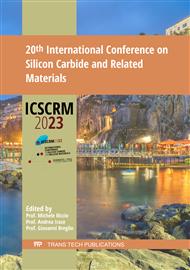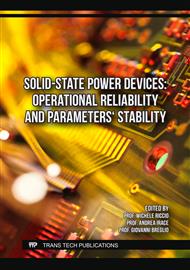[1]
Infineon, "How Infineon controls and assures the reliability of SiC based power semiconductors," in Whitepaper, Neubiberg, 2020.
Google Scholar
[2]
B. Hu and et al. , "Failure and Reliability Analysis of a SiC Power Module Based on Stress Comparison to a Si Device," in IEEE Transactions on Device and Materials Reliability, DOI:10.1109/TDMR.2017.2766692, 2017.
DOI: 10.1109/tdmr.2017.2766692
Google Scholar
[3]
C. Herold, M. Schäfer, F. Sauerland, T. Poller, J. Lutz and O. Schilling, "Power cycling capability of Modules with SiC-Diodes," in Proc. of PCIM , Nuremberg, 2014.
Google Scholar
[4]
J. Lutz, C. Schwabe, G. Zeng and L. Hein, "Validity of power cycling lifetime models for modules and extension to low temperature swings," in 21st EPE Europe, Lyon, 2020.
DOI: 10.23919/epe20ecceeurope43536.2020.9215609
Google Scholar
[5]
C. Schwabe, N. Thönelt, P. Seidel, J. Lutz and T. Basler, "Power cycling lifetime investigation under low temperature swings and 50 Hz load with experiment and simulation," in Proc. of PCIM, Nuremberg, 2021.
Google Scholar
[6]
F. Hoffmann, S. Schmitt and N. Kaminski, "Lifetime Modeling of SiC MOSFET Power Modules During Power Cycling Tests at Low Temperature Swings," in 35th International Symposium on Power Semiconductor Devices and ICs (ISPSD), Hongkong, 2023.
DOI: 10.1109/ispsd57135.2023.10147533
Google Scholar
[7]
IEC 60749-34, Semiconductor devices - Mechanical and climatic test methods - Part 34: Power cycling, Geneva: Norm, 2010.
Google Scholar
[8]
A. Gaonkar and et al., "An Assessment of Validity of the Bathtub Model Hazard Rate Trends in Electronics," in IEEE Access, DOI: 10.1109/ACCESS.2021.3050474, 2021.
DOI: 10.1109/access.2021.3050474
Google Scholar
[9]
P. Seidel, C. Herold, J. Lutz, C. Schwabe and R. Warsitz, "Power cycling test with power generated by an adjustable part of switching losses," in 19th EPE Europe, Warsaw, 2017.
DOI: 10.23919/epe17ecceeurope.2017.8099393
Google Scholar
[10]
C. Schwabe, N. Thönelt and T. Basler, "Reliability investigation of SiC MOSFETs under switching operation in various packages," in Proc. of CIPS, Berlin, 2022.
Google Scholar
[11]
R. Bayerer, T. Licht, T. Herrmann, J. Lutz and M. Feller, "Model for Power Cycling lifetime of IGBT Modules – various factors influencing lifetime," in Proceedings of CIPS, Nuremberg, 2008.
Google Scholar
[12]
C. Schwabe, N. Thönelt, J. Lutz and T. Basler, "High Cycle Fatigue Testing of Silicon IGBT Devices Under Application-Close Conditions," in IEEE Transactions on Power Electronics, DOI: 10.1109/TPEL.2023.3296269, 2023.
DOI: 10.1109/tpel.2023.3296269
Google Scholar
[13]
C. Herold, J. Franke, R. Bhojani, A. Schleicher and J. Lutz, "Requirements in power cycling for precise lifetime estimation," in Microelectronics reliability, Elsevier, 2015.
DOI: 10.1016/j.microrel.2015.12.035
Google Scholar
[14]
D. Blackburn, "An electrical technique for the measurement of the peak junction temperature of power transistors," in 13th Int. Reliability Physics Symposium, Las Vegas, 1975.
DOI: 10.1109/irps.1975.362688
Google Scholar



